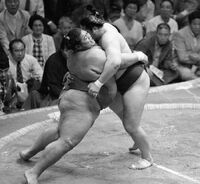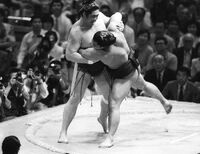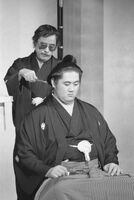Futahaguro Koji - 双羽黒 光司 (born August 12, 1963 - February 10, 2019) was a Japanese professional sumo wrestler from Tsu, Mie. He made his debut in March 1979 and last wrestled for Tatsunami stable. He reached the makuuchi division in September 1984 and has seven special prizes as well as three kinboshi. He was the 60th yokozuna and he retired in January 1988.
Early Life[]
Kitao initially practiced judo due to the recommendation from his father, but he later transitioned to sumo in elementary school. He continued his amateur sumo career at the junior high school level, and he would practice at a nearby high school with older opponents as his local junior high school did not have enough members. After graduating junior high school, he joined Tatsunami stable in March 1979.
Career[]
Early Career[]
Already Weighing 110 kg (242 Ib) and standing at 1.95 m (6 ft 5 in), Kitao was much bigger than many of his contemporaries and he won the jonokuchi yusho in his first professional tournament with a perfect 7-0 record. He was promoted to sandanme in November 1979 and makushita in January 1981. In November 1983, Kitao posted a 4-3 record at the rank of makushita 4 and was promoted to juryo in the following January 1984 tournament.
Juryo Career[]
Kitao had a strong start in his sekitori debut and by the end of the 10th day, he had already recorded 8 wins against 2 losses. However he went on a slump and lost his remains five matches to finish with a somewhat lackluster 8-7 record. He followed with two consecutive 10-5 records and was promoted to the top of juryo in July 1984. In this tournament, he won the juryo yusho with a 12-3 record and was promoted to makuuchi in the following September 1984 tournament.
Makuuchi Career[]
In his second tournament in the top division he defeated yokozuna Kitanoumi and was awarded the Outstanding Performance prize and promotion to komusubi. He made his sekiwake debut in May 1985. In July 1985 he was back in the maegashira ranks but defeated two more yokozuna and was tournament runner-up with twelve wins. After finishing runner-up once more in November 1985 he was promoted to the second-highest rank of ozeki.
Ozeki Career[]
Kitao continued his impressive performance and produced two 10-5 records in his first tournaments as ozeki. Kitao continued his rapid rise with his third runner-up performance in May 1986, followed by a 14–1 score in July, his only loss being to Hoshi. He defeated yokozuna Chiyonofuji on the final day to force a playoff with him, which Kitao lost.
Yokozuna Career[]
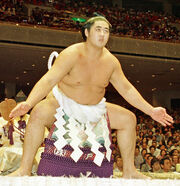
Futahaguro performs the yokozuna dohyo-iri (c. 1987)
After the 14-1 result the Japan Sumo Association were faced with a difficult decision as there was only one yokozuna on the banzuke or rankings list, but five ozeki, with a sixth wrestler – Hoshi (who would become yokozuna Hokutoumi), winner of the March 1986 tournament, already performing to ozeki standards.
The Association decided to promote Kitao to yokozuna and Hoshi to ozeki. Kitao had won 36 bouts in the last three tournaments and been runner-up in the last two, so the de facto promotional standard of "two tournament championships or the equivalent" was interpreted rather loosely. He was just 22 years old and the first person to be promoted to yokozuna without any top division tournament titles since Terukuni in 1942. The Sumo Association insisted that Kitao could no longer compete under his family name at such an exalted rank so he adopted the shikona of Futahaguro, the name being formed from those of two highly successful former yokozuna from his stable, Futabayama and Haguroyama.
The decision to promote Futahaguro backfired and he proved to be a great embarrassment to the sumo establishment. His debut as a yokozuna in the September 1986 tournament saw him pull out on the seventh day with only three wins, and after two runner-up scores in November 1986 and January 1987 a series of mediocre performances followed. His best result as a yokozuna came in November 1987 when he was runner-up for the seventh time, with a 13–2 record (losing at the hands of maegashira and also future professional wrestler, Takanofuji).
Retirement from Sumo[]
Falling Out and Expulsion[]

Futahaguro accepts his retirement after a falling out with his stablemaster (c. 1987)
Controversy was never far away from Futahaguro. Several tsukebito (junior members) of his stable refused to serve under him following an incident on the 1987 winter tour in which he physically punished one of them and as a result of this, in December 1987 he had a heated argument with his stable boss, Tatsunami, and stormed out, allegedly striking Tatsunami's wife on the way. His stablemaster handed in Futahaguro's retirement papers without consulting him and the elders of the Sumo Association voted, without giving Futahaguro a hearing, to accept it. Futahaguro became the first yokozuna ever to be expelled from sumo this way. He had lasted just eight tournaments at yokozuna rank and had proved unable to win a championship.
Professional Wrestling Career[]
Upon being dismissed by the Sumo Association, Kitao was linked with a move to America's National Football League, but instead turned to professional wrestling. To mollify the association, he dropped the shikona and reverted to his real name.
To prepare for his debut in Japan, he debuted in the United States for Verne Gagne's American Wrestling Association on November 18, 1989, through Masa Saito's connections. To keep his identity a secret to the Japanese press, he wrestled under the masked persona, Monster Machine. He defeated Frankie DeFalco in his singles debut and also teamed with Saito defeating Jim Evans & Randy Fox.

Koji Kitao (c. 1990)
Trained at the New Japan Pro Wrestling (NJPW) dojo, he made his Japanese debut on February 10, 1990, at the NJPW/AJPW Supershow in the Tokyo Dome, where he defeated Bam Bam Bigelow in a highly anticipated match. However later in July, he was fired for disrespectful conduct and racism towards Riki Choshu, who was of Zainichi Korean descent. His last match occurred on July 22, defeating Russian amateur wrestler Vladimir Berkovich in both men's last match.
Upon joining SWS in November 1990, he joined the Revolution stable and teamed with fellow former sumo Genichiro Tenryu. In an appearance at the World Wrestling Federation's WrestleMania VII, Tenryu and Kitao defeated Demolition. During his match with another former sumo-turned-pro wrestler in John "Earthquake" Tenta on April 1, 1991 at a show in Kobe, Kitao, who was booked to lose, broke kayfabe by refusing to sell Tenta's attacks, openly stalled the match, and legitimately attempted to gouge Tenta's eyes (which Tenta blocked). After being shouted at by Tenta and with the crowd chanting Tenta's name, Kitao kicked the referee and was disqualified. Afterwards he picked up a microphone and announced that wrestling was fake and Tenta could never really beat him, as other Japanese wrestlers attempted to restrain him. Kitao was fired from SWS. The Great Kabuki was also eventually fired as a SWS booker when officials discovered he had advised Tenta to stiff Kitao in an attempt to provoke his temper and get him expelled.
In the following years, Kitao briefly entered into mixed martial arts before returning to puroresu in 1992. He wrestled for various promotions such as NJPW, WAR and UWF. In 1997, he won his only title, the WAR World Six-Man Tag Team Championship, with Mochizuki and WAR rookie Nobukazu Hirai in October 1997. They retained it for a year, dropping it in 1998 against Koki Kitahara, Lance Storm and Nobutaka Araya. Koji retired from pro wrestling in October 1998, celebrating his retirement ceremony in the PRIDE 4 event.
MMA Career[]
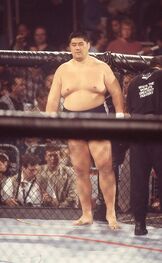
Koji Kitao prior to his UFC matchup against Mark Hall
From 1996 to 1997, Kitao would have three mixed martial arts bouts. The first of them was for the Brazilian company Universal Vale Tudo Fighting, where he faced luta livre veteran Pedro "The Pedro" Otavio. Kitao fought as a Buko Dojo representative, wearing his sleeveless karategi and being cornered by his apprentices. Started the fight, Kitao immediately rushed Pedro to the corner and took him down, gaining dominant position over him thanks to his much bigger size. The sumo champion spent most of the bout smothering Otavio from the half guard, but the Brazilian lutador eventually managed to get free and gain Kitao's back, from where he threw three vicious elbow strikes to the back of his head and neck. Kitao tapped out, but Otavio still threw four more elbows before the referee's intervention and also stepped on the back of his head after the stoppage.
Kitao's second MMA fight was at the Ultimate Fighting Championship event UFC 9, facing Mark Hall. The fight was fast, as though Kitao took him down in seconds, one of Hall's punches broke his nose and made him bleed profusely, forcing the referee to stop the match for Hall's win. Koji later was invited to PRIDE 1, where he faced future WWE employee Nathan Jones. The Australian fighter caught Kitao in a standing guillotine choke and hit some knee strikes to the gut, but Koji trapped his leg and took him down, landing in side control. Kitao then worked an americana and Jones immediately tapped.
Other Media[]
In 1996, he had an appearance in the Jean-Claude Van Damme movie The Quest as the fighting representative of Japan, a sumo champion. Kitao also appears unofficially in the games WCW vs. nWo: World Tour, and WCW/nWo Revenge, as Kim Chee.
Return to Sumo[]
In the summer of 2003 he made a surprise return to the world of sumo when he was invited to oversee some practice sessions at his former Tatsunami stable. His return was possible thanks to the retirement of Kitao's old stablemaster Haguroyama Sojo, who had been accused of illegally pocketing money from the stable fundings. Kitao was invited by the new stablemaster thanks to the makushita Haguroumi, who had served as a tsukebito to Kitao in the past. Though Kitao and Haguroumi were on bad terms, Haguroumi asked for a reappraisal of Kitao's case, and it was clear that most of what was alleged to have taken place between Kitao and Sojo was made up by the latter. Kitao was keen to continue his work at Tatsunami, but was prevented from doing so by ill health.
Personal Life and Death[]
n 2013, Kitao was diagnosed with kidney disease.
On March 29, 2019, his wife announced that Kitao had died on February 10 from chronic renal failure at the age of 55. She said in a television interview in June 2019 that her husband had also suffered from diabetes and she refused doctor's advice that he have a double leg amputation, instead nursing him at home with their daughter.
Fighting Style[]
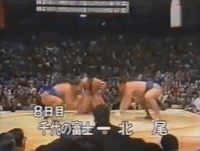
Futahaguro defeats Chiyonofuji by sukuinage (scoop throw)
Futahaguro preferred a migi-yotsu (left hand outside, right hand inside) grip on his opponent's mawashi. His favorite techniques were yorikiri (force out), oshidashi (push out), uwatenage (overarm throw), and sukuinage (scoop throw).
Record[]
Division Results[]
- Total: 348-184-24/529 (54 basho)
- Makuuchi: 197-87-16/281 (21 basho)
- Juryo: 40-20/60 (4 basho)
- Makushita: 69-49-8/118 (18 basho)
- Sandanme: 27-22/49 (7 basho)
- Jonidan: 8-6/14 (2 basho)
- Jonokuchi: 7-0/7 (1 basho)
Championships[]
- 1 Juryo Championship (July 1984)
- 1 Jonokuchi Championship (May 1979)
Achievements[]
- Special Prizes: Outstanding Performance Prize (5), Technique Prize (2)
- Kinboshi: 3: (1) Chiyonofuji, (1) Kitanoumi, (1) Hokutoumi
Shikona History[]
- Kitao Koji (1979.03 - 1986.07)
- Futahaguro Koji (1986.09 - 1988.01)









